Hello 2019
February 12, 2019 § Leave a comment
It has been a while, and as you can see on my recent posts, we’ve been traveling. So between trips and work, I’ve had very little time to explore the kitchen. I have to be honest. This recipe has been sitting in my draft box for quite a while. And while I organize my travel notes, let me share this simple corn muffin that is so easy to make and jazzed up with sharp cheeses and spicy jalpeños. This make-ahead marvel is perfect as a side dish, an appetizer, or even a snack. I love that is moist, slightly sweet, delightfully salty, marvelously cheesy, and somewhat spicy.
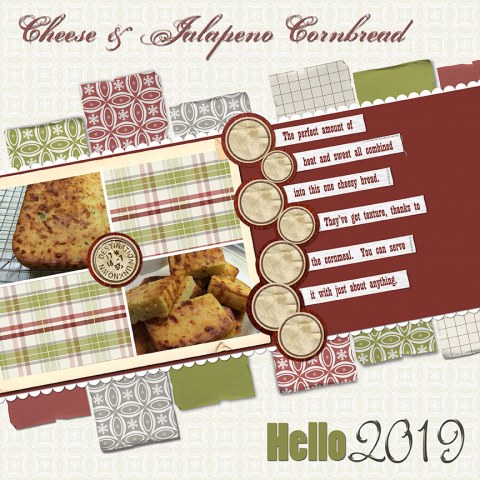 Credits: JSprague “The Final Tally” template; papers from Sepia Lane and Sept Blue CT
Credits: JSprague “The Final Tally” template; papers from Sepia Lane and Sept Blue CT
Cheese and Jalapeño Cornbread
Adapted from Martha Stewart Living October 2014 issue
What You Need:
- ¾ stick unsalted butter, melted, plus more, room temperature, for pan
- 1 ½ cups yellow cornmeal
- 1 ¼ cups all-purpose flour
- 1/3 cup sugar
- 2 tsps. baking powder
- ½ tsps.. baking soda
- 2 tsps. coarse salt
- 1 ¾ cups buttermilk
- 2 large eggs
- 8 ounces Monterey Jack cheese, shredded (about 3 cups) – I combined with Gouda
- 2 oz. or 50g Jalapeno peppers in juice/syrup
What You Do:
- Preheat oven to 200°C. Butter a 9-by-13-inch baking pan. In a bowl, whisk together cornmeal, flour, sugar, baking powder, baking soda, and salt. In another bowl, whisk together buttermilk, butter, and eggs.
- Pour buttermilk mixture into flour mixture and stir until just combined (do not overmix). Fold in cheese and chilies with juices until evenly distributed. Transfer to baking pan and smooth top.
- Bake until golden brown along edges and a tester inserted in center comes out with moist crumbs, 20-25 minutes.
- Let cool in pan 5 minutes. Turn out onto a wire rack, then invert onto another rack, top side up. Let cool at least 15 minutes more. Transfer to a cutting board. Cut into small wedges. Serve warm or room temperature.
Penang Eats
December 30, 2018 § Leave a comment
My last post for the year has to be the wonderful eating escapade we had in Penang, a food paradise mainly due to its diversity in ethnicity, culture, and religion. Its multi-ethnicity brings variety in Penang’s street and hawker food. The Thrillist named the food capital of Malaysia as one of the best food city in the world. And the food should be one of the main reasons to visit Penang.
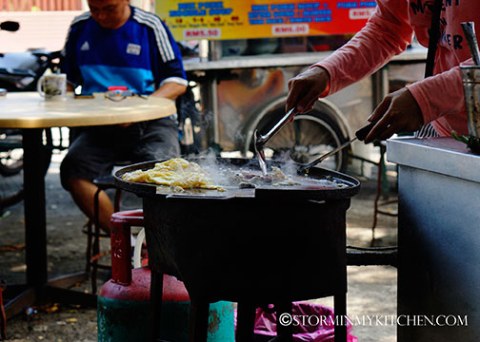
The most highly celebrated Malaysian Food is the street or hawker fare.

Expect to sit on colorful plastic tables and chairs on the roadside or in open air complex housing many food stalls.

Some of our favorites:
Char Kway Teow
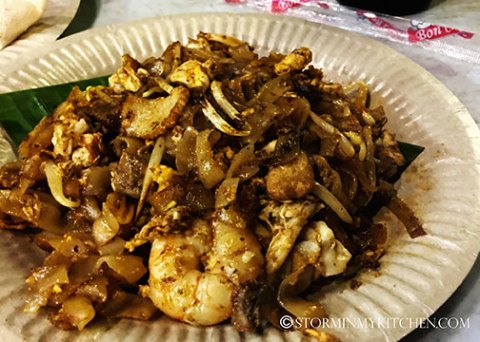
A famous dish and a national love, it’s a plate of flat rice noodles, stir-fried in a charcoal fried wok with prawns, cockles, scrambles eggs, crunchy bean sprouts, strips of fish cake and chili paste. The more famous versions will include pork lards and even sweet barbecued pork slices and use duck eggs, which results in a combination of flavors that are pretty unique. The Penang style Char Kway Teow is made special by the flavor of the “wok,” and the freshness of the ingredients.
Oyster Omelette or Oh Chien

Popular in many countries, it’s basically a fried oyster-filled omelet. The use of rice flour in the Penang version, as opposed to potato starch in others gave it a lighter, crispier texture.
Popiah
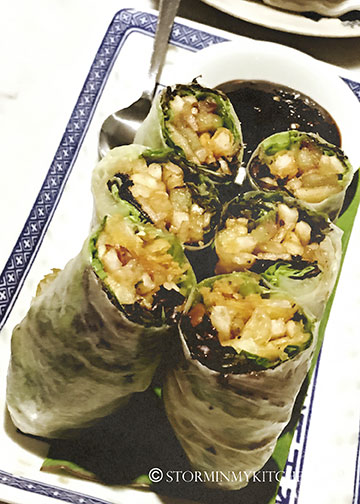
This sweet and soft creation is filled with soybean curd, grated turnips, french beans, fried tofu, chopped peanuts, shredded egg, Chinese lettuce and shrimps wrapped in a very thin crepe and served fresh.
Wantan Mee
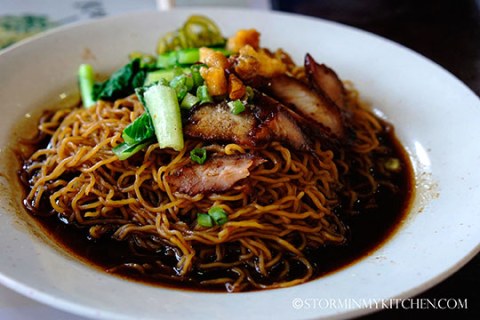
It is a delicious serving of noodles in either dry or soup form. As the name suggests, the dish is served with wanton (meat or shrimp dumplings) and char siew (barbecued pork slices). The dry version, my choice, uses dark soy sauce and perhaps oyster sauce and the soup version comes either with chicken or pork stock. Another version that I am very curious but was not fortunate enough to try (because they ran out at the Chew Getty Cafe) is the white version. They say that while it is milder than the soy sauce cousin, it delivers a flavor with more depth. No wonder it is a fast seller. Should this be my reason to go back?
Nasi Lemak
Begin your day with Malaysia’s national and traditional dish. A staple especially for breakfast, it is coconut rice served with a hot spicy sauce (sambal), fried crispy anchovies, toasted peanuts, hard-boiled eggs, and fresh cucumber slices.
Sambal is the soul of tis dish; it brings together all the various toppings and completes this iconic dish.
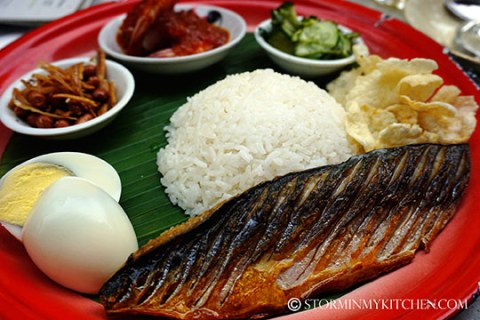 I had this superb dish at Cafe Mews with Japanese mackerel and prawn sambal.
I had this superb dish at Cafe Mews with Japanese mackerel and prawn sambal.
Crispy Duck

With the Chinese having such influence in Malaysia, it is to no surprise that Crispy duck is a popular dish served everywhere. Baste in sweet and spicy sauce and served with rice, this duck dish is deliciousness on a plate. Try it at Café Mews.
Nyonya Cuisine
The island’s claim to fame, however, is their Nyonya flavoring in the local Chinese dishes. The term Nyonya refer to the Straits Chinese immigrants who settled in Malaysia and adapted Malay tradition, customs, and cooking ingredients. The result is the Peranakan cuisines otherwise know as Nyonya.
Kebaya Restaurant
At Penang’s gorgeous Seven Terraces Hotel is a Peranakan restaurant serving an excellent repertoire of Nonya food under the leadership of creative head chef, Christopher Ong. Outstanding modern Nonya Cuisine served in a stylish dining room.

A four-course meal comes with large portions of an appetizer, vegetables, main and dessert.
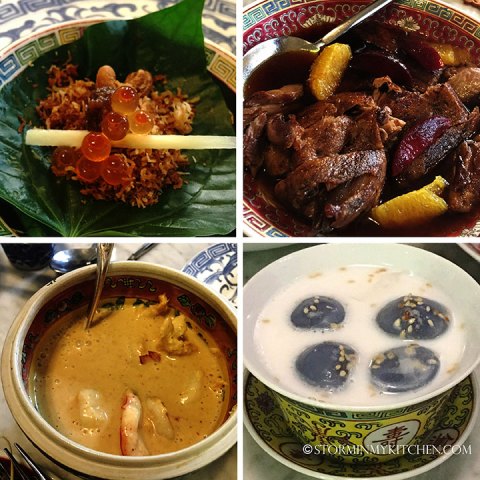
Located on Stewart Lane, Kebaya Restaurant is the best bet to sample the authentic taste of Peranakan food within Georgetown.
Indian Cuisine
Because Malaysia is a multicultural country blessed with food from the Chinese, Malay, and Indian, it is to no surprise that Indian cuisine has melded its way into its kitchen. One such dish that has become a Malaysian staple is:
Roti Canai
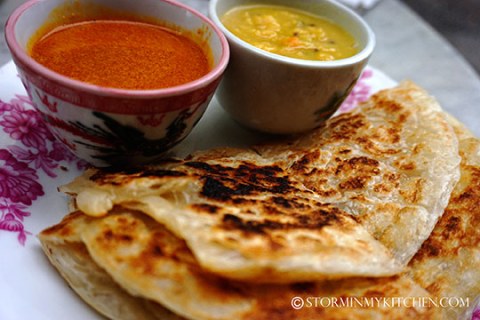
It is an adaptation of the Indian paratha roti (Indian flatbread), which made its way to Malaysian soil when the British brought South Indians to work in British Malaysia. It is one of the most basic rotis and is served with chicken curry. It is a favorite breakfast dish, but it is also served as a snack or quick lunch.
Little India
One of the most engaging side of Georgetown is the bustling, colorful Little India. It covers about 4×4 streets and is packed with shops selling beautiful saris, Indian pastries, and jewelry. But more importantly, Georgetown is home to quite a few authentic Indian restaurants.
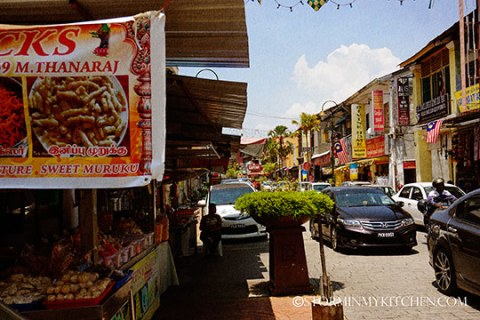
Walking around Little India after a visit to the Pinang Peranakan Museum a few blocks away, we found ourselves in Dindigul Biryani.
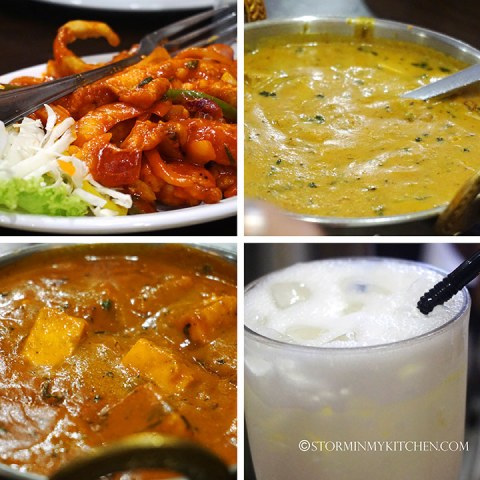
Also known as Bite N Eat to non-Indians, it is a local eatery serving Southern Indian food in a friendly and clean environment. The staff are friendly and helpful, they will help you with the menu tablet, which includes photos for the appreciation of non-Indian diners. Try their chili gobi (A spicy cauliflower starter), mutton and vegetable biryani, paneer butter masala. Portions are significant and a good value for money.
Penang’s Desserts
Also famous for its diverse range of desserts, most of which are made with local ingredients such as coconut milk, palm sugar, red beans, bananas, sweet corn, and grass jelly among others. Penang’s desserts come ranges from piping hot to refreshing. Here are some of my favorites:
Cendol

Regarded as Penang’s signature dessert and is sold almost everywhere. It is a bowl of shaved ice filled with chewy green rice flour jelly (cendol), red kidney beans, fresh light coconut milk (or condensed milk) and sweetened with a splash of palm sugar syrup. A refreshing treat on a hot day.
Ais Kacang
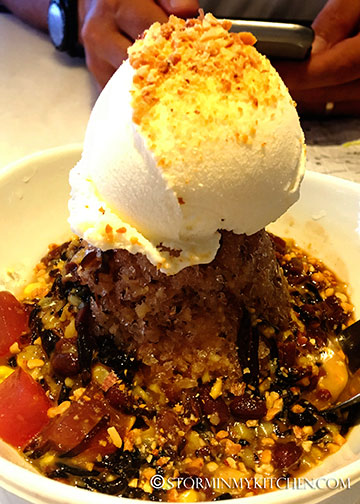
Another refreshing dessert that’s similar to cendol. Literally means “ice beans” and pronounced “ka-chong” and sometimes referred to as just ABC, it is a bowl of shaved ice comes with a serving of kidney beans. However, the number of ingredients has grown to include sweet corn, grass jelly, different fruits, and is served with coconut milk, condensed milk, or even ice cream.
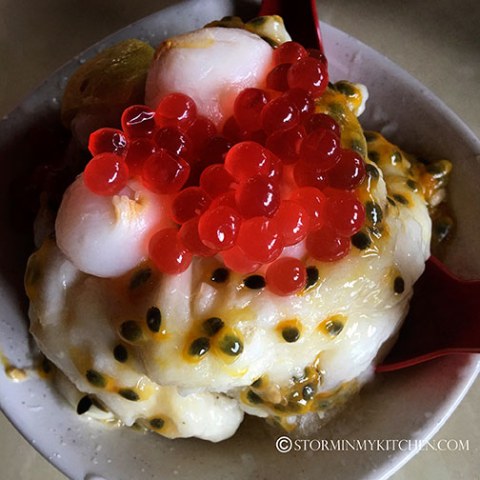
Apom Balik (turnover pancake)

Apom Balik is a sweet Nyonya-style pancake that’s stuffed with shredded coconut, sweet corn, sliced bananas or peanuts folded over and topped with a sprinkling of sugar.
Nyonya Kuih
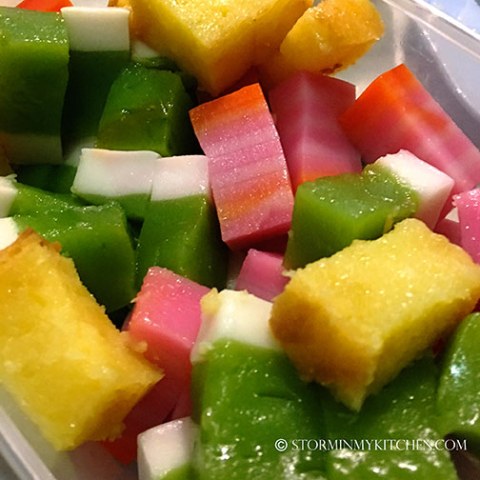
They are bite-size gems that are soft, almost pudding-like in texture. With appealing colors dominated by flavors of coconut, pandan and palm sugar, these dainty bites are a Peranakan delicacy that has been handed down from generation to generation.
Durian
Last but definitely not the least for durian lovers, where else can you find the best durian but in the island of Penang – the haven of hybrid durians.
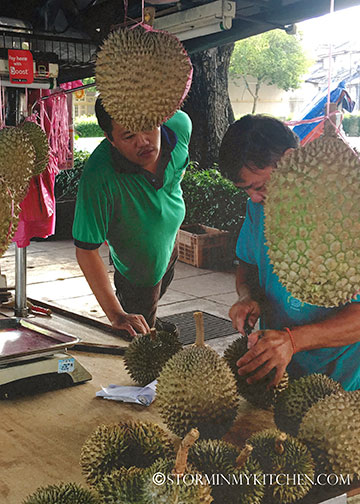
At the time of our visit, it was pretty much the end of the season, and our Grab taxi driver brought us to Leng Durian at Anson Road, the few stalls still selling the fruit albeit at a very high price.

Durian, for those unfamiliar, is one of the world’s most exciting foods. While many associate it with its odor, it is a fruit that is a strange combination of savory, sweet and creamy all at once. And for durian lovers, it is one of the reasons to travel to Penang.
And with this, I wish you all a Blessed 2019.
Where to Eat in KL: Jalan Alor
October 9, 2018 § Leave a comment
Decked out on Jalan Alor is an impressive collection of roadside eateries and street food vendors. Plastic tables and chairs adorn a good portion of the street.
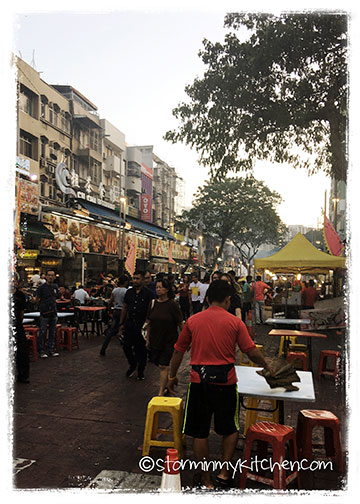
If you are looking for the perfect example of Malaysian food, look no further. This strip running parallel to Jalan Bukit Bintang is best known for its budget-friendly street food eateries.
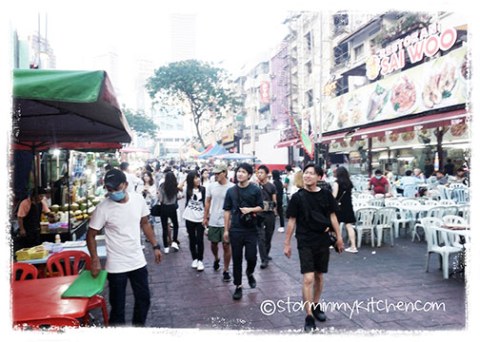
Wander around, choose the stall/s that piqued your fancy and enjoy the gastronomic journey.

Fresh oysters. We chose Dragon View Restaurant for its oysters. Along with it sitting by the roadside, we had a feast of Fried Garlic Prawns, Chili Crab, Sweet and Sour pork and an order of Won Ah Wah’s famous BBQ chicken wings.

“Sometimes, the simple things are more fun and meaningful than all the banquets in the world.”
― E.A. Bucchianeri
Easy Going in Taipei
July 4, 2018 § 1 Comment
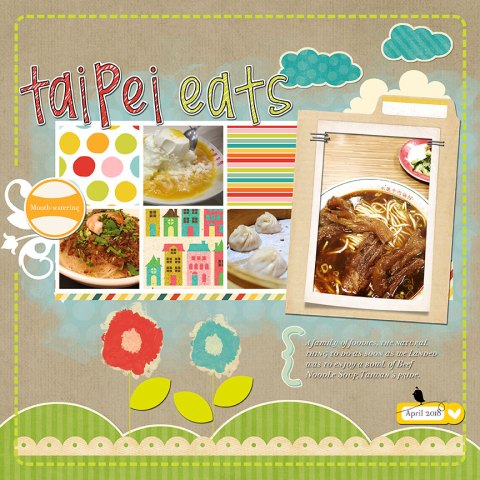 I fell in love with Taiwan and vowed to return and explore the other parts of the island. Well, it took us seven years (unbelievable but true), this time with parents in tow. And so we didn’t venture too far away from Taipei.
I fell in love with Taiwan and vowed to return and explore the other parts of the island. Well, it took us seven years (unbelievable but true), this time with parents in tow. And so we didn’t venture too far away from Taipei.
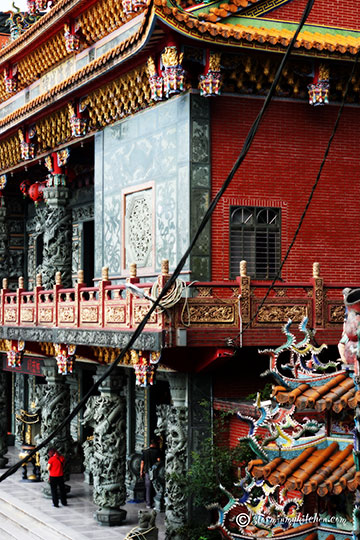
Fushan Temple in Jiufen

Honeycomb rocks in Yehliu
The itinerary was loose and relaxed with only 1 full day outside the capital. A family of foodies, the natural thing to do as soon as we landed was to enjoy a bowl of Beef Noodle Soup, Taiwan’s pride. While there are several recommended spots for this, we chose Yonkang Beef Noodle.
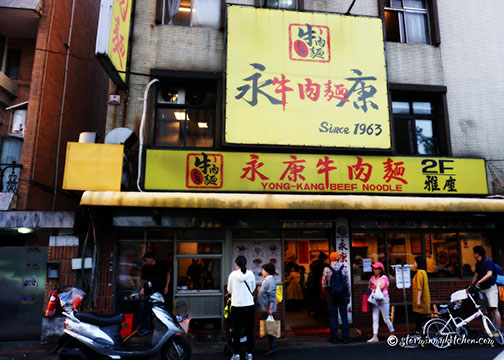
Founded in 1963, this small family run, 2-level restaurant serves up signature beef noodle and tendon soup.
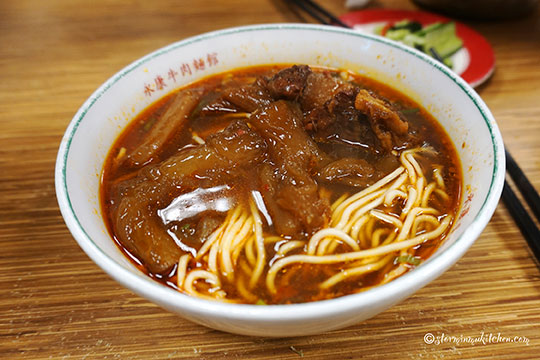
It’s Sichuan style hot and spicy soup with huge chunks of tender Australian beef – cooked to perfection and best with a bit of their fantastic chili paste.
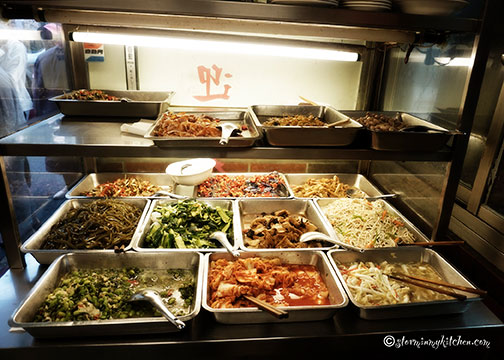
Besides having a large variety of side dishes, the restaurant also serves steamed spare ribs and steamed intestines – something to try next time.
Yongkang Street
We walked off that fantastic noodle soup in Yongkang Street, Taiwan’s cuisine mecca. It is not a very long street, but one can spend an hour or two just browsing. Not to be missed when visiting Taipei.
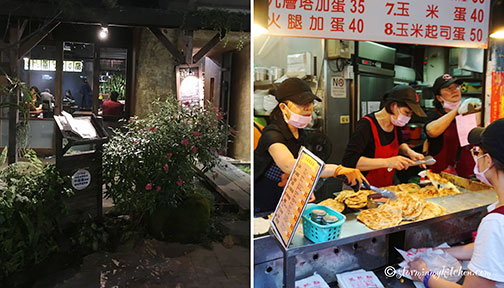
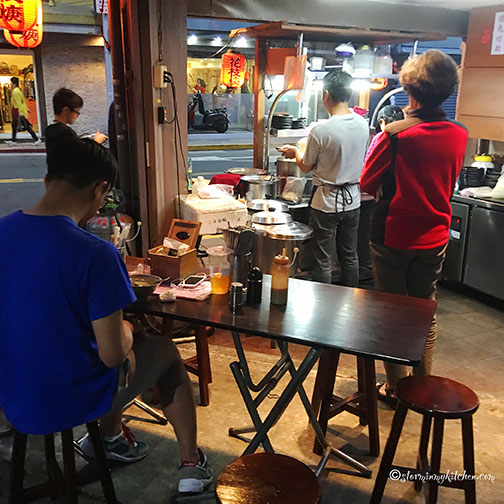
Initially owning fame for its traditional cuisines such as Din Tai Fung’s xiao long bao, Yongkang Street and its neighboring lanes and alleys are now dotted with old-school eateries, coffee shops and dessert shops, clothing and souvenir shops, tea shops and some quirky cafes.
Kao Chi
And speaking of xiao long bao, we found another gem just around the corner from Din Tai Fung serving a similar menu but is far less crowded. Perpetually overshadowed by its heavyweight competitor, Kao Chi has been serving Shanghainese dishes since 1949, about 8 years earlier than Din Tai Fung. The 3-story flagship store is quiet, though somewhat a favorite among the affluent locals. Signature dishes include their Shen Jian Bao – pan-fried pork buns, Xiao Long Bao (of course) – Steamed Pork Dumplings, and Steamed Crab Egg and Pork Dumplings, among a wide array of dishes on the menu.
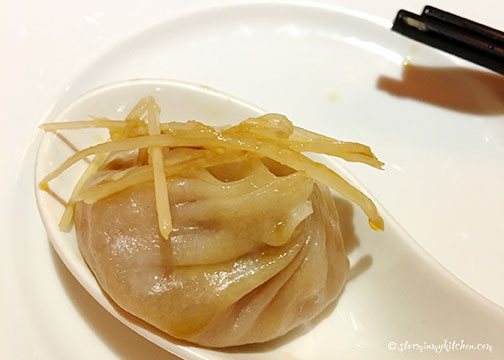
Still full from the massive bowl of Beef Noodle Soup, we opted for an order of Xiao Long Bao, not knowing then about the pan-fried pork buns (later on recommended by a local friend). I find that the XLB was equally good, and we didn’t have to wait in line for it. Another option to keep in mind for XLB fans.
Tu Hsiao Yueh
Another noteworthy restaurant not to miss is Tu Hsiao Yueh. Highly recommended by a Taiwanese friend, we didn’t waste time to go check it out. Established in Tainan in 1895 with an interesting story to boot. The name means “survive a month” or “living through the bad months” referring to the hardship endured by the fishermen in Tainan. In those months, a fisherman named Hung would go to town and sell Dan Tzai noodles in front of the local temple to make ends meet.
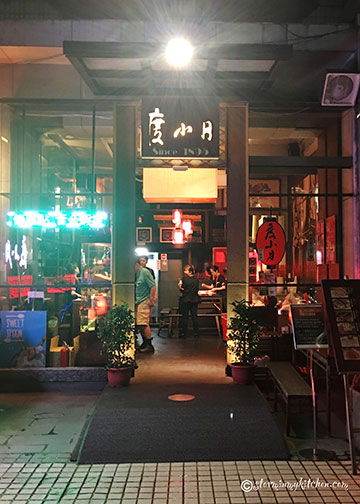
Fast forward to present day, Tu Hsiao Yueh has evolved into a modern restaurant chain serving traditional Taiwanese fare and still specializing in the same noodles that is now a Taiwan staple.
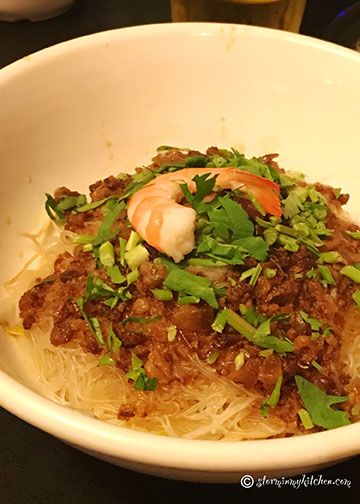
The signature dish is a small bowl of noodles topped with minced meat, dried shrimps, and black vinegar. One can choose between egg noodles, rice vermicelli or bihon, or flat noodles, and if you want it with or without soup. We decided on the dry bihon just because I love bihon that way. I was pleased with our choice, but I heard that the soup was exceptional and elevated the dish. That gives me another reason to go back.

Fried Oysters, Stir-fried Tomiao, Minced beef topped rice (reminds of my youth…)
Fried oysters with white pepper and salt on the side was another remarkable dish that we enjoyed so much that we placed a second order – A definite must try!
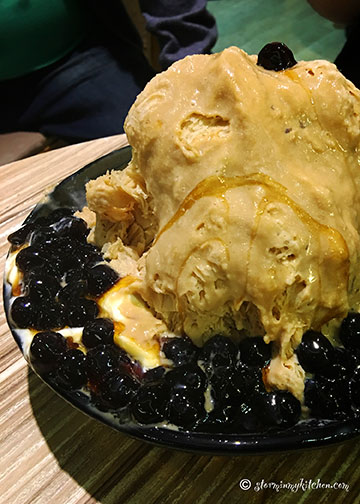
We followed it up with a bowl of Bubble Milk Tea Sensation – shaved ice dessert likewise made famous by the Taiwanese. Ah… another must.
Useful Info:
Yongkang Beef Noodle: No. 17, Lane 31, Section 2, Jinshan South Road, Da’an District, Taipei City, Taiwan 106
Kao Chi Branches:
No. 1, Yongkang Street, Da’an District, Taipei City
No. 150號, Section 1, Fuxing South Road, Da’an District
Tu Hsiao Yueh branches:
No. 9-1, Yongkang Street, Da’an District, Taipei City
No. 12, Alley 8, Lane 216, Section 4, Zhongxiao East Road, Da’an District, Taipei City
Ice Monster Zhongxiao Flagship branch: No.297, Section 4, Zhongxiao East Road, Taipei
Nutella Banana Bread
March 14, 2018 § Leave a comment
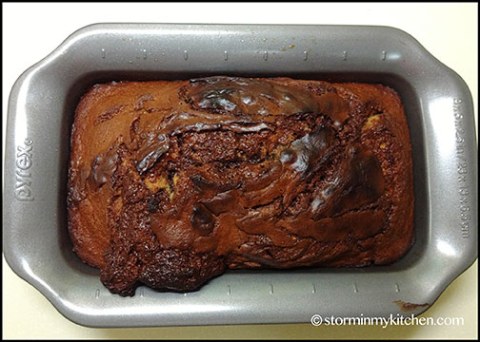
I go bananas over bananas, but for a household of two, I end up with brown, overripe, or just too much. By now, I’ve found ways to use them. I make pancakes, I freeze for smoothies (my obsession at the moment), and I make banana bread. I’ve got tons of recipes to choose from too.
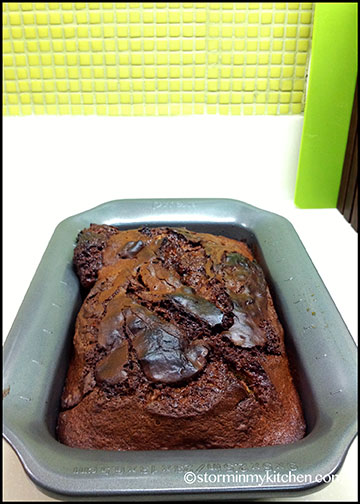
So one morning, while the world was fast asleep and I still awake, I looked through my pantry and found a bottle of Nutella staring at me—a gift from Christmas that I didn’t dare open lest I fall into a Nutella binge. What better way to consume it than to incorporate it with the overripe bananas in the ref and be rewarded with this Nutella Banana Bread. Recipe here.
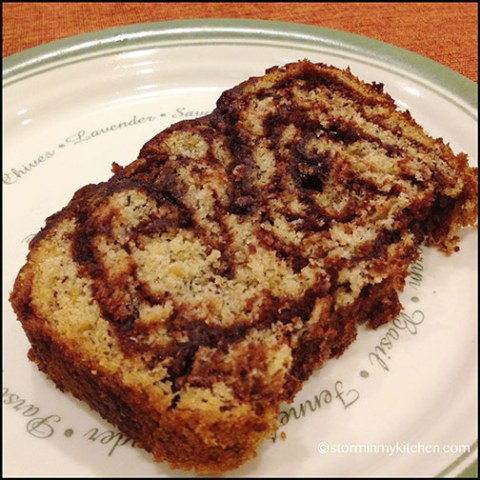
What to Eat in Myanmar: Laphet Thoke
January 11, 2018 § 1 Comment
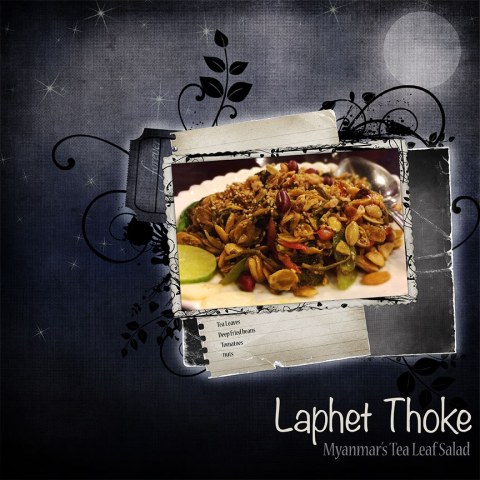 Credits: Quick page by retrodiva {designs}
Credits: Quick page by retrodiva {designs}
Laphet, also spelled lakphet, lephet is fermented or pickled teal leaf, and it has a very long history in Myanmar. Thoke means salad. Myanmar’s national dish is a salad made of tea leaves.
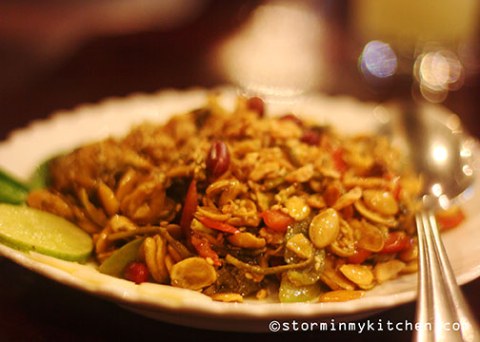
Teashops around Myanmar pour gallons of green and black tea every day yet half of the tea consumption is eaten not drunk. An extraordinary characteristic of its national dish is the delicate use of fermented tea leaves.
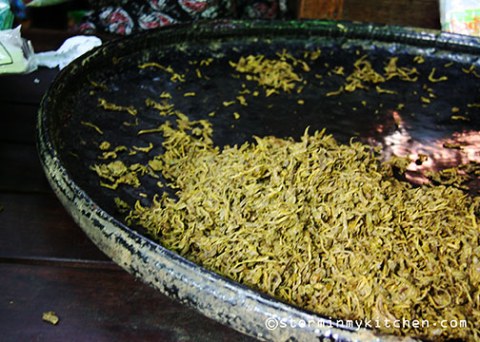
The slightly bitter leaves are mixed by hand with shredded cabbage, sliced tomatoes, crunchy deep fried beans, nuts and peas, toasted sesame seed, crushed fried shrimp, a splash of garlic oil and slices of chili and garlic. It’s actually a versatile dish that can be eaten as a snack, an appetizer or with rice, a meal hard to miss when in Myanmar, actually. I instantly fell in love with it and prefer to take it as an appetizer – it has lovely textures and flavors that is umami, tangy, and savory in one mouthful.
Myanmar culture is diverse and multi-ethnic and their cuisine is testament to it.
What to Eat in Hokkaido: Jingisukan
September 23, 2017 § 2 Comments
 Credits: Jsprague TW Dialog template; papers by Splendid Finns’ You are Awesome and Sus Design’s Saving Memories Kit.
Credits: Jsprague TW Dialog template; papers by Splendid Finns’ You are Awesome and Sus Design’s Saving Memories Kit.
Named after the Mongolian ruler, Genghis Khan, Jingisukan is essentially Hokkaido-style Yakiniku.

In a dome-shaped cast iron looking a lot like the helmet of the Mongolian soldiers, thinly sliced meat (in this case, lamb or mutton) is grilled on the table and shared family style much like how the Koreans do it. It also reminded me of the Laotian Barbecue (sans the soup) I so enjoyed in Luang Prabang some years back. An unforgettable meal, that was. Come to think of it, Asian cuisines although diverse in flavors have a lot of similarities, especially in how meals are cooked and shared.
On our last night in Asahikawa, we chose a restaurant close to our hotel, highly recommended on Foursquare.

The line was not visible when we arrived because it was so long, the weather so cold; we were asked to wait in a room across the restaurant. It was worth the wait. Right off the grill and dipped in a soy-based sauce, the lamb was superb.

It was tender and flavorful and not gamey at all. We ordered several cuts and all were satisfying. Do find your way to a Jingisukan place when in Hokkaido. Better yet, if you find yourself in Asahikawa, make sure to look for Jingisukan Daikokuya. It could be your best meal in Hokkaido.
Other Must-Eats when in Hokkaido:
The island of winter sports, hanging cliffs, and endless lavender fields is also known to offer the best food adventures in Japan.

In fact, it is one of its biggest attractions, specifically its seafood and agricultural products grown on its extensive farmlands.

The prefecture has a massive dairy industry that produces about half of Japan’s milk and other dairy products like butter, cheese, yogurt and ice cream.

The best melon in Japan is grown here too, making it quite a popular flavor for milk and ice cream.

And of course, don’t forget to grab some of Hokkaido’s famous cheesecake.
Jingisukan Daikokuya 5 Chome 4-jodori,3,4 Naka, Asahikawa +81 188-24-2424
Korea On My Mind
August 22, 2017 § Leave a comment
I’m almost halfway through my Korean visa, and I should make better use of that 5 years that they’ve given me. So here I am planning a mini Korean holiday that is getting me more excited by the minute.

I imagine chicken and beer or chimek, mageoli, kimbap, fresh kimchi, samgyeopsal, deep-fried mandu, haemul pajeon, bingsu… My mouth water at the thought of grilled Hanwoo beef that melts in the mouth and I remember our incredible meal in Hongdae. And then my mind wanders to the other food I have to yet to have. I promised to go back for— jjajangmyeon, samyetang, soy sauce crab, sundae (not the frozen dessert but Korea’s blood sausage that got my attention because of these twins) and much more that I’m still not aware of.
So now I crave Japchae. That’s a Korean-style noodle dish that is usually served as a side dish consisting of vermicelli noodles, meat, and assorted vegetables sautéed in soy sauce. This version is without meat, and even my meat-loving hubby gave his thumbs up.

Japchae (Korean Style Noodles)
Adapted from this recipe in Epicurious
What You Need:
- 5-6 ounces Korean vermicelli noodles
- ½ cup soy sauce
- 3 Tbsp. Sesame oil
- 3 Tbsp. sugar
- 2 cloves chopped garlic
- 1 Tbsp. oil
- 1 med onion sliced lengthwise 1/8 inch thick (1 ½ cups)
- 3 medium carrots, cut into 1/8 inch thick matchsticks
- 1 ½ cup mushrooms, trimmed and sliced thick
- 1 ½ cup snow peas (recipe called for spinach but I didn’t have that)
What you do:
- Soak noodles in a bowl of warm water to cover until softened, about 10 minutes, then drain in a colander. Cook noodles in a 3-4 quart pot of boiling water until tender, about 2 minutes, then drain in a colander and rinse under cold water until cool.
- Blend soy sauce, sesame oil, sugar, and garlic in a blender until smooth.
- Heat oil in a deep 12-inch heavy skillet over high heat until it just begins to smoke, then stir-fry onion and carrots until onion is softened. About 3 minutes.
- Add mushrooms and stir-fry until softened, about 3 minutes.
- Add snow peas and stir-fry 30 seconds, then add noodles and soy sauce mixture and toss to coat.
- Simmer, occasionally stirring, until most liquid is absorbed, 3-5 minutes.
- Serve warm or at room temperature.
Chocolate and Orange
March 16, 2017 § Leave a comment

A combination that the hubby absolutely adores, and I have, through him, learned to love as well. I’m not exactly a chocolate kind of girl but this union has made me crave it at times. It’s now my combination of choice when it comes to chocolate. If you’re wary of the fusion, one taste of this will make you a believer.

The recipe I found was weak in orange flavor, so I added grated orange and orange liqueur, preferably Grand Marnier, on the frosting.

And because a quarter has almost past that I’ve been silent on the blog front, here’s the recipe without further ado…
Chocolate Orange Cupcakes (tweaked from a Williams-Sonoma Cake Recipe)
What You’ll Need:
- 3 tablespoons Dutch-processed cocoa powder
- ¼ cup hot water
- 1 ¼ cups unbleached all-purpose flour
- ½ teaspoon each baking powder and baking soda
- ¼ teaspoon salt
- 1 -2 oranges (depending on the size; I used 1 large orange)
- 2 large eggs, at room temperature
- ¾ cup granulated sugar
- ½ cup buttermilk, at room temperature
- ½ teaspoon vanilla extract / essence
- ¼ cup unsalted butter, melted and cooled to room temperature
For the Frosting
- 6oz. (170g) bittersweet chocolate
- 1 cup unsalted butter, at room temperature
- 2 cups confectioner’s (icing) sugar
- 2 tablespoons orange liqueur
- 1 tablespoon orange zest
What You Do:
- Preheat the oven to 350ºF (180ºC). Line 12 standard muffin cups with paper liners.
- In a small bowl, stir the cocoa powder into the hot water until dissolved; set aside. Sift the flour, baking powder, baking soda, and salt together into a bowl. Grate the zest from the orange into the bowl. Set aside.
- In a large bowl, whisk together the eggs and granulated sugar until well combined. Whisk in the buttermilk and vanilla, then the dissolved cocoa. Whisk in the melted butter, then the dry ingredients.
- Using a tablespoon, divide the batter among the muffin cups, filling each about half full. Bake until the cupcakes are puffed, and a skewer inserted into the center of one comes out clean 15-20 minutes. Let cool completely on a wire rack. Remove the cupcakes from the pan.

- To make the frosting, melt the chocolate and let cook to room temperature. Meanwhile, using a stand mixer, beat the butter and confectioner’s sugar with the paddle on medium speed until creamy and smooth, about 3 minutes. Beat in the melted chocolate, orange liqueur, and zest until combined. Fill a pastry bag fitted with a ½ inch (12mm) star tip with the frosting and pipe a spiral on top of each cupcake. Refrigerate the cupcakes for 30 minutes before serving to set the frosting. Makes 12 cupcakes.
Melting Chocolate
To melt chocolates, chop it into small pieces and put it in a stainless-steel bowl. Set the bowl in a saucepan over but not touching, barely simmering water. Heat until the chocolate melts, stirring occasionally. Do not allow any water or steam to come in contact with the chocolate, or it will become stiff and grainy. Or, chop the chocolate into large pieces, place in a microwave-safe dish, and microwave on low for 1 minute. Continue to microwave if necessary, checking every 20 seconds, until the chocolate looks softened, then stir until smooth and liquid.
What to Eat in Kunming: Across the Bridge Noodle Soup
January 16, 2017 § Leave a comment
 Credits: JSprague Digi In Deeper Course Material
Credits: JSprague Digi In Deeper Course Material
This noodle soup dish has a typical Yunnan local flavor that could only be had in some parts of Yunnan and carries with it a love story. A scholar, preparing for the imperial exams retreated to an island in a lake. The wife delivers lunch to him daily, crossing a long wooden bridge. Dismayed that she couldn’t keep it warm, figured out that adding a thin layer of fat on top prevents the heat from escaping. And by doing this, she discovered that she could bring the broth across the bridge and cook the rest of her Noodle Soup there.
And with that, I had our driver bring us to Qiao Xiang Yuan, a restaurant chain famous for its Guo Qiao Mi Xian, which translates to Across the Bridge or Crossing Bridge Rice Noodle.

Driver Wang ordered for us. Minutes later an attractive mix of ingredients laid before us. There were slices of lightly cooked (some raw) meats, Yunnan ham, strips of bean curd sheets, mushrooms, vegetables, rice noodles (of course) and a piping hot broth with a layer of chicken fat and oil glistening on top, the key to this noodle soup. The meat sliced wafer thin so that it will cook almost immediately when added to the broth. Once the vegetables and noodles are added, stir it a bit, and the Guo Qiao Mi Xian is ready to eat.

A must try when in Kunming.
To read more about Kunming and Yunnan, read this and this.
Qiao Xiang Yuan: Shulin Jie, Wenhua District, near Jinbi Guang Cheng
